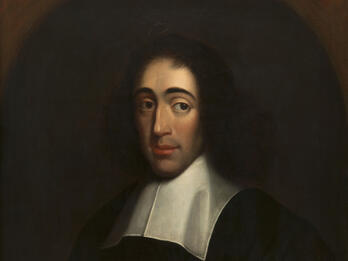El Conciliador (The Reconciler)
Question 8
Genesis 1:26. Let us make man in our image, as our likeness.
Genesis 9:6. For in the image of God made he man.
Deuteronomy 4:15. And guard ye your souls greatly, for ye saw no manner of similitude, on the day that the Lord spoke onto you at Horeb.
God having no material figure or corporeal form, how is it said, “God made man in his image?”
Reconciliation
For the solution of this doubt, and to understand the verse properly, it is necessary, in the first place, to explain the word בצלמו “in our image,” the word צלם having various meanings in the Holy Scriptures.
1st. The countenance and corporeal form: as, describing Nebuchadnezzar when irritated, it says, וצלם אנפוהי אשתני “And the form of his visage was changed.” [Daniel 3:19]
צלמי זכר “Male images,” [Ezekiel 16:17] in which sense it is often found in the sacred writings.
2nd. It is used for the spiritual form of man, that is, the intellectual comprehension, as it is said, “Adam begat Seth” בצלמו “In his image,” [Genesis 5:3] this cannot be understood in respect of bodily members, for every father begets children in a similar manner, but the Scripture means, that Adam being most wise begat a wise son, and therein was his image and likeness.
3rd. It is applied to that subtlety termed by Plato “the celestial vehicle,” and by Cabalists צלם “Ideal form.” David spake of this in saying, אך בצלם יתהלך איש “Surely in an image (or shade) walketh man,” [Psalms 39:7] meaning, that mankind being constituted of opaque earthy matter, and a spiritual soul, there is something which connects these extremes; and this is צלם or an extremely subtle and diaphanous object, approaching to a spirit.
4th. It is a shade or shadow, from which is derived צלמון a shade, and צלמות the shadow of death, as many passages of Scripture testify.
Proceeding then to solve the doubt: If in saying, “Let us make man,” God spoke with secondary causes, or with angels, then by “image” must be understood a representation of the three worlds, for which reason he is termed “Microcosm”; if he spoke to the earth only, then, by “image” the body must be understood, and by “likeness” the soul and understanding, which in spirituality resembles God. If it is only a figure of speech as used by the Great, to speak in the plural, then, as Plato says, there pre-existed in the divine mind all the ideas of the creation, and God chose to make man in such a manner, that the perfections of the whole should combine in him, in such a degree and mode as the subject was capable of; and as in God, a most simple unity, these are super-eminent, so it may be said that man is a shadow of it; therefore, it is not because an image is required, that corporeality in God is implied, for it should be explained in the foregoing manner. [ . . . ]
Question 18
Psa. 51:2. When Nathan the prophet came unto him after he had gone in unto Bath-sheba.
Psa. 51:4. Against thee alone have I sinned and done the evil in thy sight.
Where David’s conduct with Bath-sheba offended Uriah’s honour, how could he say to thee alone, O Lord, I have sinned?
Reconciliation
Some infer from the latter verse, that princes are accountable to God alone for their actions. Others collect from it that David did not commit adultery, from the divorce it was usual for a man to give his wife when he went out to battle; nor of homicide, for Uriah had committed the crime of treason, but this is difficult to prove: the most probable is the explanation of R. David Kimchi and other interpreters, that Uriah being dead, there was no one but God to whom he could confess the sin, or from whom he could implore pardon; for which reason he said, “to thee alone, O Lord, have I sinned; to thee only I confess my sin.”
Or, according to R. David Kimchi, David’s sin was private and secret; for, although he sent for Uriah, none knew why he was summoned, nor why he caused his death, but suspected he had been guilty of the crime of treason, and, as a secret sin, when the prophet Nathan came to speak to him, to God only he ought then to confess it. By which the doubt is solved.
Published in: The Posen Library of Jewish Culture and Civilization, vol. 5.



